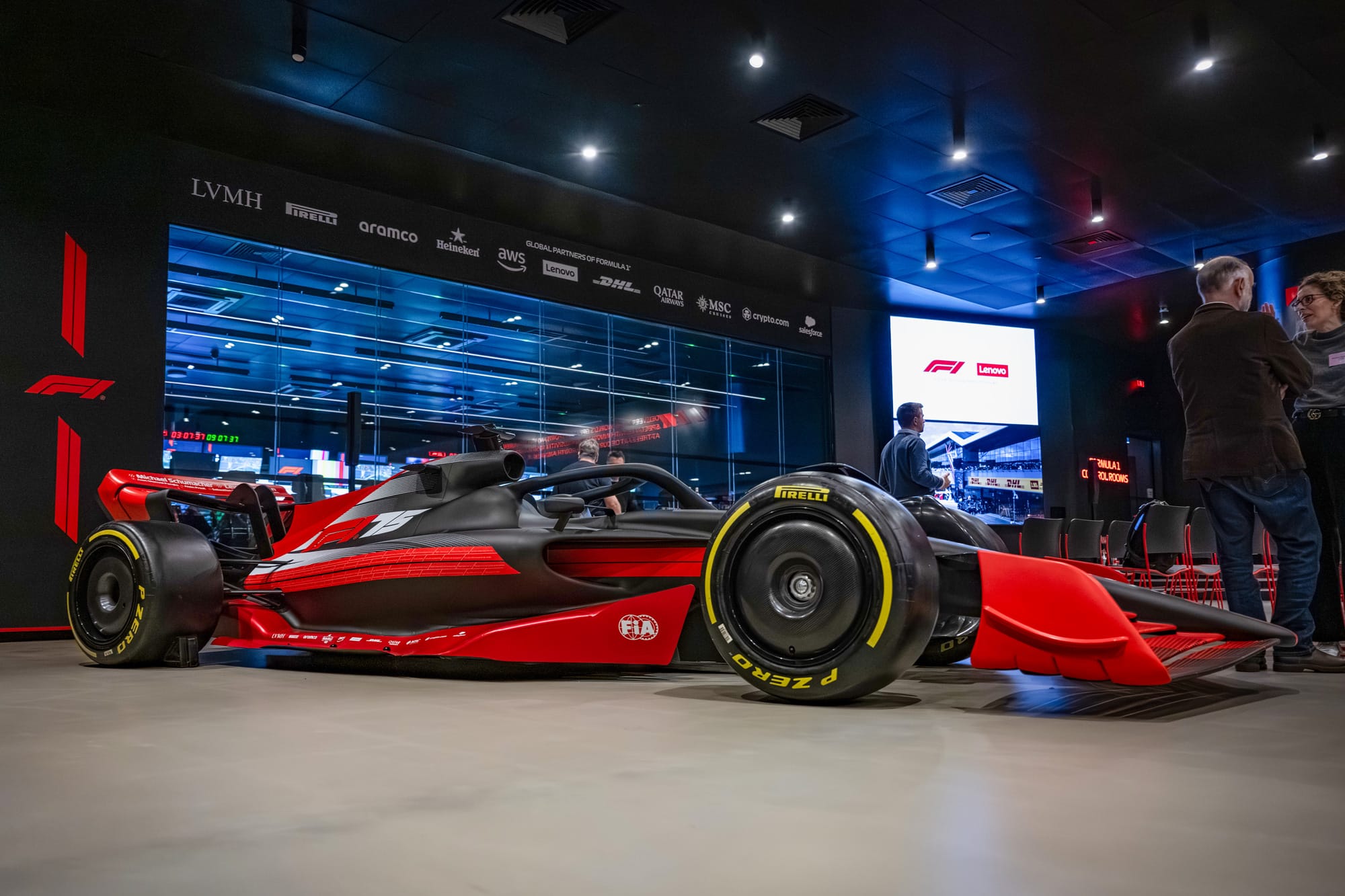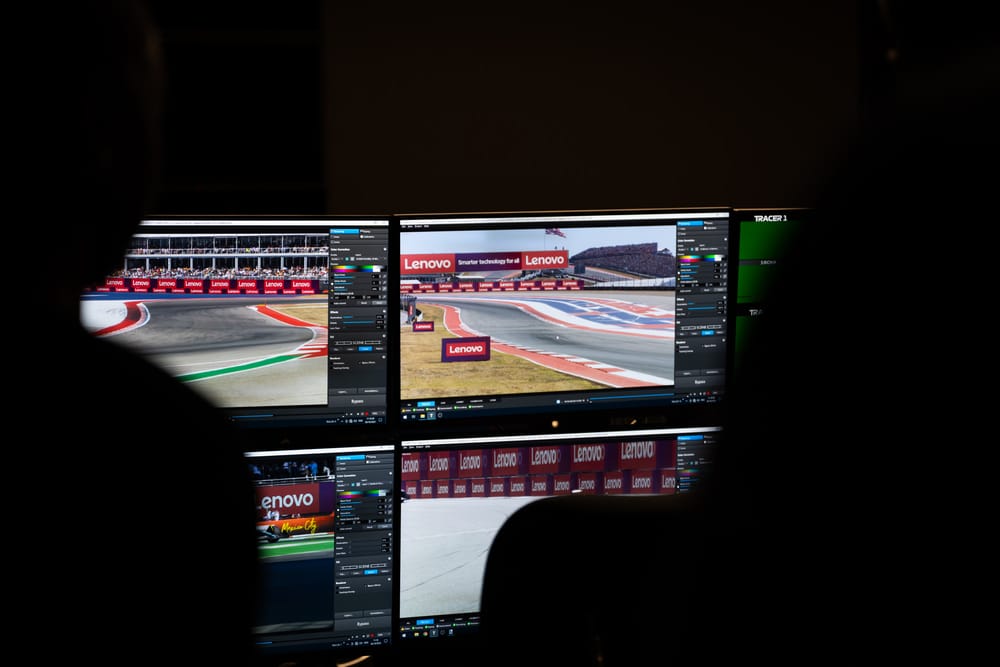On the outskirts of an unassuming town in the leafy London Borough of Bromley gently hums the world's most advanced sports broadcasting facilities.
Once home to a Royal Air Force airfield and fighter station, Biggin Hill now plays host to Formula 1's Media & Technology Centre (M&TC), where the escapades of a different breed of pilots are processed into the broadcast video feed for over 820 million viewers around the world.
We recently took a look behind the scenes.
The remote
F1's M&TC is a state-of-the-art production complex like no other. This centralised hub manages how every F1 weekend is captured, from the audio-visual (live camera feeds, team radios, and region-specific virtual signage to name but a few) to telemetry (interpreting 1.1million data points from every single car into on-screen graphics) and houses the F1 TV studio and multiple commentary booths.
Working in tandem with the on-site Event Technical Centre (ETC), a behemothic roaming broadcast facility present at every race. A colossal 600 terabytes of data is transferred between the two facilities per event weekend, with bandwidth peaking at around 8.5 GB/s at the start of an event.

Upon entering the recently refurbished M&TC, arrows guide visitors down a hallway furnished with vignettes and memories from F1's recent history. At the end of the corridor, the guest experience area opens up to reveal a glass wall that frames the vast Media Control Room.
This is motorsport's ultimate mission control, a gallery equipped with cutting-edge technology operating at a breakneck pace and a volume of screens you would associate more with launching a rocket into space.
The ambitious pace of operation of the MT&C mirrors the action on track. During the Christmas break in 2021, Chris Roberts, Formula 1's director of IT, had a plan to work with F1's global technology partner Lenovo to improve the agility of the IT infrastructure to better cope with the ever-growing demands.
"I took the rather brave decision to virtualise the whole of our M&TC environment prior to the start of the 2022 season," he says.
"I put in the call for the hardware, we had the [Lenovo] engineers onsite, where we virtualised and containerised the whole of our core infrastructure. From conception to delivery, and cars on track, it took just 10 weeks."
From the MT&C two video feeds are created; first is the world feed, the international TV broadcast received by over 180 territories. Second is the content for F1TV, delivering an overwhelming array of F1 video and audio content for a direct-to-consumer streaming service.
Adapting the MT&C to this set-up has meant recontextualising what the facility is to F1. Historically, the majority of the processing and publishing systems were located in the on-site ETC. However, a virtualisation of the broadcast process gives the Biggin Hill site the ultimate remote control of TV production.
Dean Locke, director of broadcast and media for F1, explains: "This place used to be called 'The Remote'. Actually, we quickly found out this wasn't the remote bit; if anything, the track is the remote bit now."
The COVID-19 pandemic also played a role in fast-tracking the technological advancement of the facility.
"[In 2020] we had a long-term plan to go remote in five years, but that had to be condensed down to three months," explains international feed director Phil Rorke.
"From the time we got back from Melbourne and went into hibernation, we concentrated on how we were going to separate one broadcast into two parts; one travelling, one staying back in Biggin Hill.
"In three months we separated everything out, found the right technology for us with a stable platform that had minimal delay between what we do here and what is going on at the circuit."
To give some context as to how minimal that delay really is, Rorke cites the Australian round in Melbourne to be the race with the longest delay between action on track and video footage reaching the MT&C. In true F1 style though, this lag is a mere 160 milliseconds. The onboard footage is marginally longer as this is processed differently, but even these feeds are beamed directly back to Biggin Hill rather than being handled on site.
There are also environmental gains to be had by this approach, reflective of F1's target of becoming Net Zero by 2030 in all aspects of its output.
Virtualisation of the server racking and broadcast control sheds significant freight weight from the ETC (resulting in a major reduction in carbon emissions each race) and removes the risk for travel-related damage to hardware, no longer compromised by the vibrations and perils of international travel.
By removing constraints from the limitations of operating on site, the centralised approach means the IT and production team can be more considered as they evolve the technology that modern broadcast demands. When you consider the rapidly depleting length of days available for off-season development, these efficiency improvements are crucial.
'One screen to tell the story'

For all the diverse platforms and methods by which global audiences consume sport in the 21st century, the main broadcast feed is still king.
Its director Rorke is tasked with the weighty responsibility to help weave the narrative, absorbing input from the live camera feeds, replays, team radios, making an average of 5000 cuts every race weekend.
"We just have that one screen to tell the story," he explains from the media control room, where banks and banks of monitors and workstations display a bewildering array of an entire race action all at once.
As our visit to the MT&C occurs outside a race weekend it is notable for its lack of personnel, where usually every seat would be occupied by a production team member with a focused role to help build the story. When fully occupied, there is a crucial necessity to remain calm throughout the broadcast.
"It can get pretty hectic," Rorke admits. "At the start of a race there's a lot going on, and the noise level here does increase quite considerably.
"But I believe in running a very calm environment, because shouting at people doesn't work and puts you on the back foot."
Disaster recovery
While there is an ambition to have "zero capacity for failure", F1 is live sport and inevitably, unforeseen disruptions can happen. The FP1 session of the 2025 Mexican Grand Prix is a rare example of one such outage, revealed by Rorke to be caused by workers digging up a road in the wider Mexico City area.
"Here, you can't really do anything and all of a sudden the screens go green, and then that's it," he admits. "It's not easy because the teams and the FIA are relying on our infrastructure.
"We lost our link so produced the programme from the circuit. We've got the flexibility to be on constant standby so that we can operate the press conference, the presentation and post’race interviews so they are ready to go."
'DR' (disaster recovery) is practiced every Thursday before a race weekend with a high-speed test which involves the team flipping to satellite-based broadcasting from the team on the ground in the ETC, with minimal delays to proceedings, producing the show from there.
'Radio check'
Delving deeper into the facility, we enter the radio room, the control centre for the driver radio clips that filter through to the world feed.
Having direct audio is a rich seam for crafting the story of the race and helps both commentators and audiences delve deeper into driver strategies, as well as creating fan-favourite interactions.
The eight-person audio team consists of a team radio producer, editors, listeners and a transcriber, with a ninth member joining the crew in 2026 to deal with the increased pressure of Cadillac team's arrival on the grid.
With backgrounds in sound engineering and music production, the team radio crew are tasked with filtering a cacophony of 20 simultaneous conversations all with different microphone set-ups into clear and digestible clips to be at the disposal of international feed director Rorke as he marries up the audio with what is seen on screen.
Split second decisions have to be made by the producer choosing the audio clips as to their narrative relevance. Clips are organised into three tiers of radio communications: fully transcribed with audio; audio-only; and text-only (eg the race engineer's 'Box, box' request for the driver to pit).
The target is to play out radio messages either within 15 seconds or on the current lap, with the only exceptions being replays, overtakes and for less-time-critical communications.
Like so much of our world's ever-increasing reliance on technology, AI looms in the not-too-distant future to provide a solution. There are plans for AI tools to be implemented to speed up radio transcription but, arguably, the team is already operating on a hugely impressive turnaround without this.



